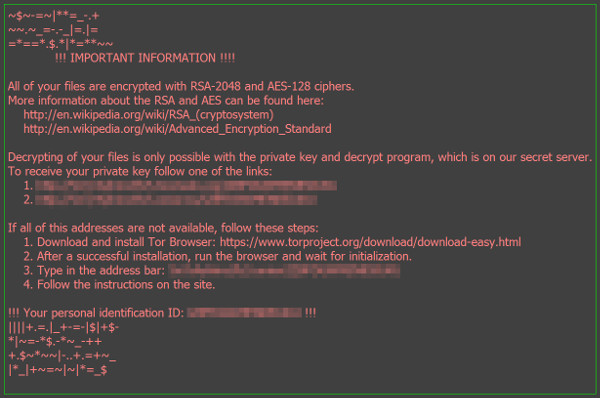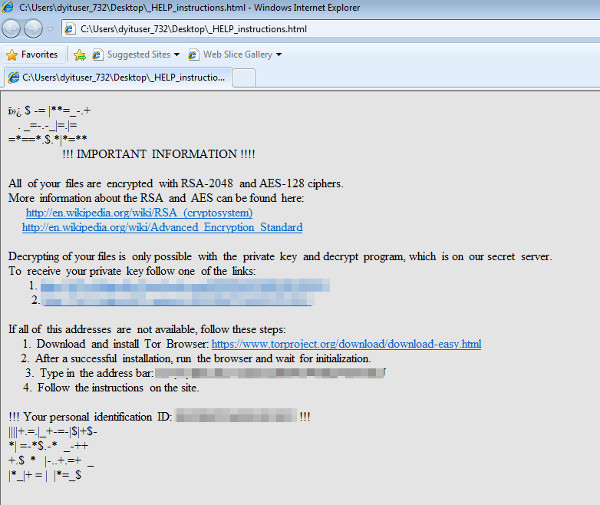RANSOM_LOCKY.DLDVFQ
TR/Locky.aipiec (Avira); TrojanRansom.Locky (CAT-QuickHeal); Trojan-Ransom.Win32.Locky.bqr (Kaspersky); Ransom.Locky (Symantec)
Windows


Threat Type: Trojan
Destructiveness: No
Encrypted: Yes
In the wild: Yes
OVERVIEW
This Trojan may be downloaded by other malware/grayware from remote sites.
It does not have any propagation routine.
It does not have any backdoor routine.
TECHNICAL DETAILS
Arrival Details
This Trojan may be downloaded by the following malware/grayware from remote sites:
Installation
This Trojan drops the following files:
- {folder containing encrypted files}\_{count of dropped note per folder}_HELP_instructions.html - ransom note
It drops and executes the following files:
- %Desktop%\_HELP_instructions.html - ransom note
- %Desktop%\_HELP_instructions.bmp - image used as wallpaper
(Note: %Desktop% is the desktop folder, where it usually is C:\Documents and Settings\{user name}\Desktop in Windows 2000, Windows Server 2003, and Windows XP (32- and 64-bit); C:\Users\{user name}\Desktop in Windows Vista (32- and 64-bit), Windows 7 (32- and 64-bit), Windows 8 (32- and 64-bit), Windows 8.1 (32- and 64-bit), Windows Server 2008, and Windows Server 2012.)
Other System Modifications
This Trojan modifies the following file(s):
- It encrypts files in fixed, removable, RAM disk drives, and network shares.
- It renames the encrypted files to {unique ID per victim}-{identifier}.zepto
It adds the following registry entries as part of its installation routine:
HKEY_CURRENT_USER\Control Panel\Desktop
Wallpaper = %Desktop%\_HELP_instructions.bmp
Propagation
This Trojan does not have any propagation routine.
Backdoor Routine
This Trojan does not have any backdoor routine.
Other Details
This Trojan encrypts files with the following extensions:
- .001
- .002
- .003
- .004
- .005
- .006
- .007
- .008
- .009
- .010
- .011
- .123
- .3dm
- .3ds
- .3g2
- .3gp
- .602
- .7z
- .ARC
- .CSV
- .DOC
- .DOT
- .MYD
- .MYI
- .NEF
- .PAQ
- .PPT
- .RTF
- .SQLITE3
- .SQLITEDB
- .XLS
- .aes
- .apk
- .asc
- .asf
- .asm
- .asp
- .asset
- .avi
- .bak
- .bat
- .bik
- .bmp
- .brd
- .bsa
- .bz2
- .c
- .cgm
- .class
- .cmd
- .cpp
- .crt
- .cs
- .csr
- .d3dbsp
- .das
- .db
- .dbf
- .dch
- .dif
- .dip
- .djv
- .djvu
- .docb
- .docm
- .docx
- .dotm
- .dotx
- .fla
- .flv
- .forge
- .frm
- .gif
- .gpg
- .gz
- .h
- .hwp
- .ibd
- .iwi
- .jar
- .java
- .jpeg
- .jpg
- .js
- .key
- .lay
- .lay6
- .lbf
- .ldf
- .litemod
- .litesql
- .ltx
- .m3u
- .m4a
- .m4u
- .max
- .mdb
- .mdf
- .mid
- .mkv
- .mml
- .mov
- .mp3
- .mp4
- .mpeg
- .mpg
- .ms11
- .ms11 (Security copy)
- .n64
- .odb
- .odg
- .odp
- .ods
- .odt
- .onetoc2
- .otg
- .otp
- .ots
- .ott
- .p12
- .pas
- .pem
- .php
- .pl
- .png
- .pot
- .potm
- .potx
- .ppam
- .pps
- .ppsm
- .ppsx
- .pptm
- .pptx
- .psd
- .pst
- .qcow2
- .rar
- .raw
- .rb
- .re4
- .sav
- .sch
- .sh
- .sldm
- .sldx
- .slk
- .sql
- .stc
- .std
- .sti
- .stw
- .svg
- .swf
- .sxc
- .sxd
- .sxi
- .sxm
- .sxw
- .tar
- .tbk
- .tgz
- .tif
- .tiff
- .txt
- .uop
- .uot
- .upk
- .vb
- .vbs
- .vdi
- .vmdk
- .vmx
- .vob
- .wallet
- .wallet.dat
- .wav
- .wb2
- .wk1
- .wks
- .wma
- .wmv
- .xlc
- .xlm
- .xlsb
- .xlsm
- .xlsx
- .xlt
- .xltm
- .xltx
- .xlw
- .xml
- .zip
It does the following:
- It deletes shadow copies by executing the following command:
- vssadmin.exe Delete Shadows /Quiet /All
- It prevents encrypting files containing any of the strings in its full path name:
- winnt
- Application Data
- AppData
- Program Files (x86)
- Program Files
- temp
- thumbs.db
- $Recycle.Bin
- System Volume Information
- Windows
NOTES:
It displays the following ransom note:


SOLUTION
Step 1
Before doing any scans, Windows XP, Windows Vista, and Windows 7 users must disable System Restore to allow full scanning of their computers.
Step 2
Note that not all files, folders, and registry keys and entries are installed on your computer during this malware's/spyware's/grayware's execution. This may be due to incomplete installation or other operating system conditions. If you do not find the same files/folders/registry information, please proceed to the next step.
Step 3
Restart in Safe Mode
Step 4
Search and delete these files
- {folder containing encrypted files}\_{count of dropped note per folder}_HELP_instructions.html
- %Desktop%\_HELP_instructions.bmp
- %Desktop%\_HELP_instructions.html
Step 5
Remove the malware/grayware file that dropped/downloaded RANSOM_LOCKY.DLDVFQ. (Note: Please skip this step if the threat(s) listed below have already been removed.)
- JS_NEMUCOD.ELDSAOL
Step 6
Restart in normal mode and scan your computer with your Trend Micro product for files detected as RANSOM_LOCKY.DLDVFQ. If the detected files have already been cleaned, deleted, or quarantined by your Trend Micro product, no further step is required. You may opt to simply delete the quarantined files. Please check this Knowledge Base page for more information.
Step 7
Restore encrypted files from backup.
Step 8
Reset your Desktop properties
Did this description help? Tell us how we did.


